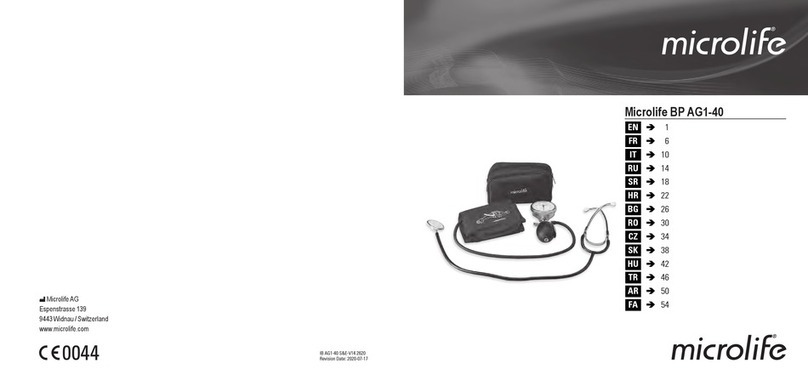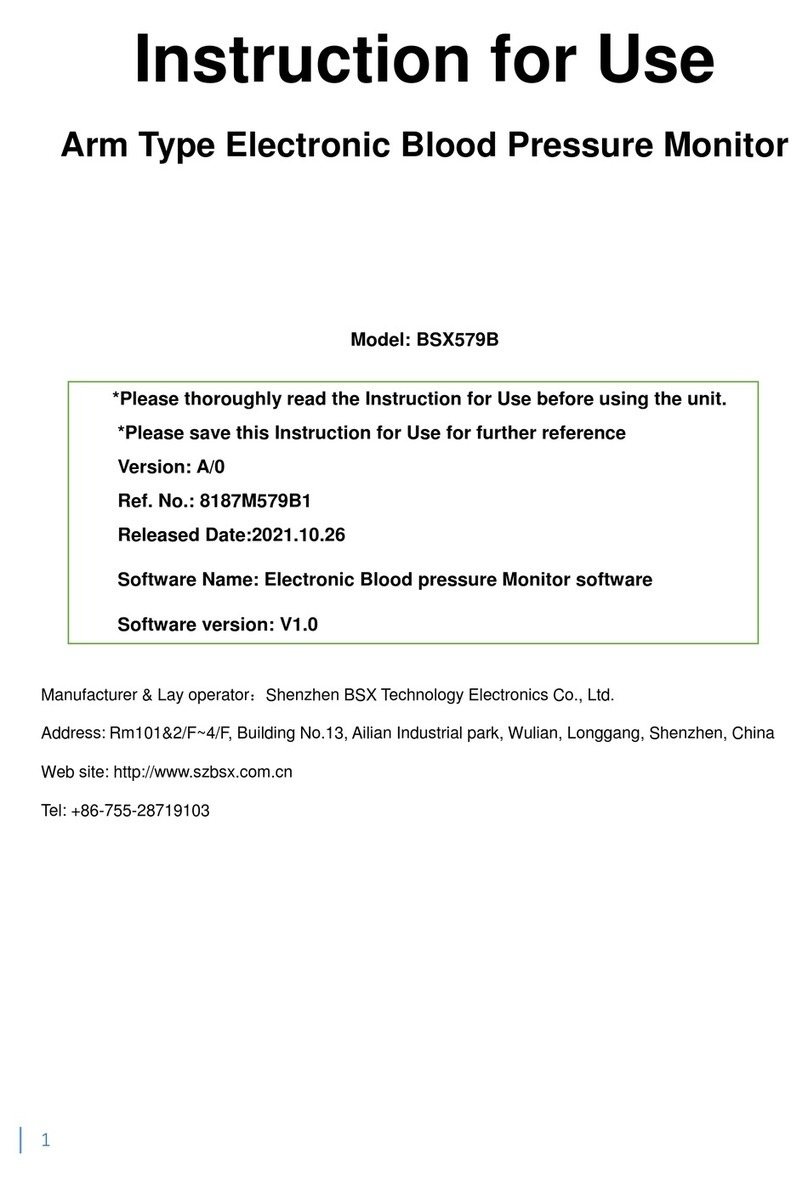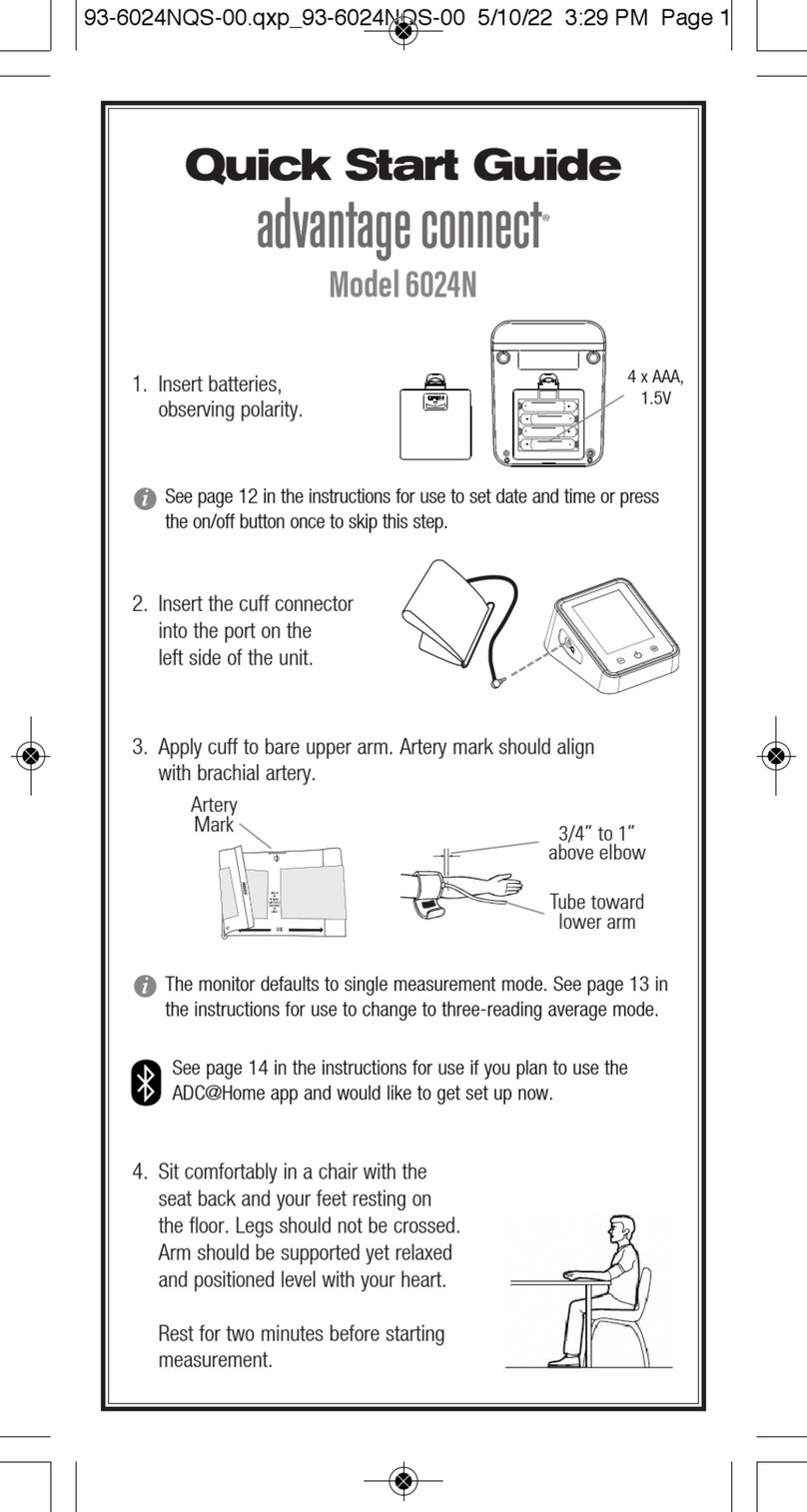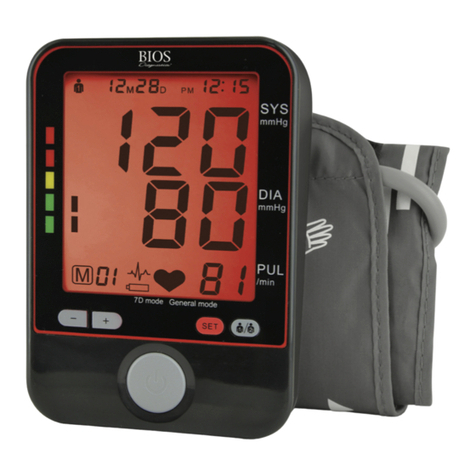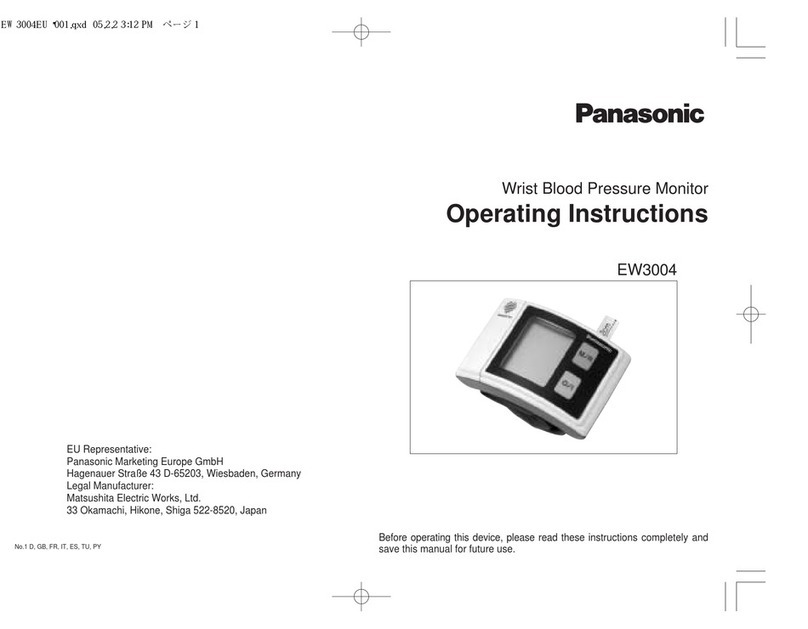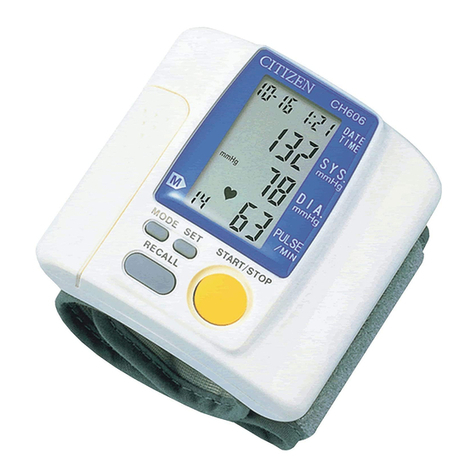dynarex 7096 User manual

1. INTRODUCTION 3. OPERATION (Cont.)
1.1. FEATURES OF THE DIGITAL BLOOD PRESSURE MONITOR
The Digital Blood Pressure Monitor (with integrated time/date display) is a fully
automatic, digital blood pressure measuring device for use on the arm, which
enables very fast and reliable measurement of the systolic and diastolic blood
pressure as well as the pulse frequency by way of the oscillometric method of
measuring. The device offers a very high and clinical tested measurement
accuracy and has been designed to provide a maximum of user-friendliness.
The device is intended for self-use at home. Before using, please read through
this instruction manual carefully and then keep it in a safe place. For further
questions on the subject of blood pressure and its measurement, please contact
your doctor.
1.2. IMPORTANT INFORMATION ABOUT SELF-MEASUREMENT
• Substitution of a different component might result in measurement error.
• Cuff is replaceable only by an original.
• Do not use with neonatal patients.
• It will cause harmful injury to the patient or effect the blood pressure due to
connection tubing kinking.
• Too frequent measurements can cause injury to the patient due to blood flow
interference.
• The application of the cuff over a wound can cause further injury.
• The application of the cuff and its pressurization on any limb where intravascu-
lar access or therapy, or an arteriovenous (A-V) shunt, is present because of
temporary interference to blood flow and could result in injury to the patient.
• Do not let the cuff and its pressurization on the arm on the side of a mastecto-
my.
• The need to check that operation of the automated sphygmomanometer does
not result in prolonged impairment of patient blood circulation.
• Not intended to be used together with HF surgical equipment.
• Do not forget: self-measurement means control, not diagnosis or treatment.
Unusual values must always be discussed with your doctor. Under no circum-
stances should you alter the dosages of any drugs prescribed by your doctor.
• The pulse display is not suitable for checking the frequency of heart pacemak-
ers!
• In cases of cardiac irregularity (Arrhythmia), measurements made with this
instrument should only be evaluated after consultation with the doctor.
Electromagnetic interference
The device contains sensitive electronic components (Microcomputer).
Therefore, avoid strong electrical or electromagnetic fields in the direct vicinity
of the device (e.g. mobile telephones, microwave cookers). These can lead to
temporary impairment of the measuring accuracy.
2. BLOOD PRESSURE MEASUREMENT
2.1. HOW DOES HIGH/LOW BLOOD PRESSURE ARISE?
The level of blood pressure is determined in a part of the brain, the so-called
circulatory centre, and adapted to the respective situation by way of feedback via
the nervous system. To adjust the blood pressure, the strength and frequency of
the heart (Pulse), as well as the width of circulatory blood vessels is altered. The
latter is effected by way of fine muscles in the blood-vessel walls.
The level of arterial blood pressure changes periodically during the heart
activity: During the «blood ejection» (Systole) the value is maximal (systolic
blood pressure value), at the end of the heart’s «rest period» (Diastole) minimal
(diastolic blood pressure value).
The blood pressure values must lie within certain normal ranges in order to
prevent particular diseases.
2.2. WHICH VALUES ARE NORMAL?
Blood pressure is too high if at rest, the diastolic pressure is above 90 mmHg
and/or the systolic blood pressure is over 160 mmHg. In this case, please
consult your doctor immediately. Long-term values at this level endanger your
health due to the associated advancing damage to the blood vessels in your
body.
Should the systolic blood pressure values lie between 140 mmHg and 160
mmHg and/or the diastolic blood pressure values lie between 90 mmHg and 100
mmHg, likewise, please consult your doctor. Furthermore, regular self-checks
will be necessary.
With blood pressure values that are too low, i.e. systolic values under 100 mmHg
and/or diastolic values under 60 mmHg, likewise, please consult your doctor.
Even with normal blood pressure values, a regular self-check with your blood
pressure monitor is recommended. In this way you can detect possible changes
in your values early and react appropriately. If you are undergoing medical
treatment to control your blood pressure, please keep a record of the level of
your blood pressure by carrying out regular self-measurements at specific times
of the day. Show these values to your doctor. Never use the results of your
measurements to alter independently the drug doses prescribed by your doctor.
Table for classifying blood pressure values (unit: mmHg) according to World
Health Organization:
Further information
• If your values are mostly standard under resting conditions but exceptionally
high under conditions of physical or psychological stress, it is possible that you
are suffering from so-called «labile hypertension». Please consult your doctor
if you suspect that this might be the case.
• Correctly measured diastolic blood pressure values above 120mmHg require
immediate medical treatment.
TABLE OF CONTENTS
1. Introduction................................................................................................... 2
1.1. Features of the Digital Blood Pressure Monitor....................................2
1.2. Important Information about Self-Measurement................................... 2
2. Blood Pressure Measurement...................................................................... 2
2.1. How Does High/Low Blood Pressure Arise? ........................................2
2.2. Which values are normal?....................................................................2
3. Operation...................................................................................................... 2
3.1. Inserting the Batteries ..........................................................................2
3.2. Setting the Date/Time/Pressure Unit....................................................3
3.3. User Selection ......................................................................................3
4. Carrying Out a Measurement .......................................................................3
4.1. Before the Measurement......................................................................3
4.2. Common Sources of Error....................................................................3
4.3. Fitting the Cuff ...................................................................................... 3
4.4. Measuring Procedure: Standard Single Mode and
MAC Mode (two-measurement mode) .................................................4
4.5. Discontinuing a Measurement..............................................................4
4.6. Memory – Storage and Recall of the Measurements ...........................4
4.7. Memory Full.......................................................................................... 4
4.8. Memory – Cancellation of All Measurements .......................................4
5. Error Messages/Malfunctions....................................................................4-5
6. Care and Maintenance, Recalibration ..........................................................5
7. Guarantee .................................................................................................... 5
8. Service Life...................................................................................................5
9. Battery Life ................................................................................................... 5
10.Safety, Care and Disposal.........................................................................5-6
11. Reference to Standards ...............................................................................6
12.Technical Specifications ...............................................................................6
13.Declaration – Electromagnetic Emissions ....................................................6
4.3. FITTING THE CUFF
Insert air connector into air outlet shown in the
photo and please make sure the fitting of the air
connector completely and properly to avoid air
leakage.
a) The distance between the edge of cuff and
the elbow should be approx. 2~3 cm.
b) Secure the cuff with the Velcro fastener,
so that it lies comfortably and not too tight,
whereby no space should remain between
the cuff and the arm.
c) Lay the arm on a table, with the palm
upwards. Support the arm a little with a rest
(cushion), so that the cuff rests at about the
same height as the heart. Take care, that the
cuff lies free. Remain so for 2 minutes sitting
quietly, before beginning with the measure-
ment.
d) Let legs uncrossed, feet flat on the floor,
back and arm supported.
Reorder No. 7096
Range
Optimum
Normal
Slightly High
Too High
Far Too High
Dangerously High
Systolic
100 -120
120-130
130-140
140-160
160 -180
180 and up
Diastolic
60-80
80-85
85-90
90-100
100-110
110 and up Urgently seek medical advice!
Measures
Self-check
Self-check
Consult your doctor
Seek medical advice
Seek medical advice
3.2. SETTING DATE/TIME
How to enter to the setting mode:
a) after batteries are inserted, the device will automatically enter to the
setting mode.
b) press and hold “ ” (ON/OFF) button for 5 seconds, the device will enter
to the setting mode
The setting procedure as follows:
It is essential to set date and time. Otherwise, you will not be able to save
your measured value correctly with a date and time.
Use the button to make adjustments.
If you press and hold the button, you can set the values more quickly.
1. Year setting: the year flashes on the display
Choose the desired year with the button and confirm with “ ”
(ON/OFF) button.
2. Month setting: the month flashes on the display
Choose the desired month with the button and confirm with “ ”
(ON/OFF) button.
3. Day setting: the day flashes on the display
Choose the desired day with the button and confirm with “ ”
(ON/OFF) button.
4. Hour setting: the hour flashes on the display
Choose the desired hour with the button and confirm with “ ”
(ON/OFF) button.
5. Minute setting: the minute flashes on the display
Choose the desired minute with the button and confirm with “ ”
(ON/OFF) button.
6. Unit setting: the unit “kPa” or “mmHg” flashes on the display
Choose the desired minute with the button and confirm with “ ”
(ON/OFF) button.
NOTE: the clock will begin to run from 2016-01-01 01:01, and unit in mmHg,
if no key is pressed within 20 seconds.
3.3. USER SELECTION
Press and hold the memory button for 2 seconds, flash on the
display. Press to choose the desired user.
Year Month Day Hour Min. Unit (mmHg/KPa)
4. CARRYING OUT A MEASUREMENT
4.1. BEFORE THE MEASUREMENT
• Avoid eating, smoking as well as all forms of exertion directly before the
measurement. All these factors influence the measurement result. Try and
find time to relax by sitting in an armchair in a quite atmosphere for about ten
minutes before the measurement.
• Measure always on the same arm (normally left).
• Attempt to carry out the measurements regularly at the same time of day,
since the blood pressure changes during the course of the day.
4.2. COMMON SOURCES OF ERROR
NOTE: Comparable blood pressure measurements always require the same
conditions! These are normally always quiet conditions.
• All efforts by the patient to support the arm can increase the blood pressure.
Make sure you are in a comfortable, relaxed position and do not activate any
of the muscles in the measurement arm during the measurement. Use a
cushion for support if necessary.
• The performance of the automated sphygmomanometer can be affected by
extremes of temperature, humidity and altitude.
• Avoid compression or restriction of the connection tubing.
• A loose cuff causes false measurement values.
• With repeated measurements, blood accumulates in the respective arm,
which can lead to false results. Correctly executed blood pressure measure-
ments should therefore first be repeated after a 5 minute pause or after the
arm has been held up in order to allow the accumulated blood to flow away
(after at least 3 minutes).
3. OPERATION
3.1. INSERTING THE BATTERIES
a) Insert the batteries (4 x size AA 1.5V), thereby observing the indicated
polarity.
b) the battery warning appears in the display, the batteries remain 20%
power to warn user the batteries will be run out.
c) If the battery warning appears in the display, the batteries are empty
and must be replaced by new ones.
Attention! After the battery warning appears, the device is blocked until
the batteries have been replaced.
• Please use «AA» Long-Life or Alkaline 1.5V Batteries.
• If the Digital Blood Pressure Monitor is left unused for long periods, please
remove the batteries from the device.
Digital Blood
Pressure Monitor
Upper Arm
MAC Mode
Standard Single Mode
ON/OFF Button
Memory Button
1
DC
6V
MAC switch
Standard single mode
MAC mode
M-L size
2-3 cm
22-42 cm
Time and Date
User Systolic
Value
Diastolic
Value
MAC Mode
Traffic Light Display
Low Battery Warning
Pulse
Memory Set No.
Pressure unit
Memory Symbol
Heart Arrhythmia Indicator
Heart Symbol
Air
Connector
Cuff

5. ERROR MESSAGES/MALFUNCTIONS (Cont.)
Other possible malfunctions and their elimination
If problems occur when using the device, the following points should be
checked and if necessary, the corresponding measures are to be taken:
6. CARE AND MAINTENANCE, RECALIBRATION
7. GUARENTEE
The Digital Blood Pressure Monitor is guaranteed for 2 years from date of
purchase. The guarantee does not apply to damage caused by improper
handling, accidents, not following the operating instructions or alterations made
to the instrument by third parties. The guarantee is only valid upon presentation
of the guarantee card filled out by the dealer.
9. BATTERY LIFE
1000 times measurement with 4 AA alkaline batteries
10. SAFETY, CARE AND DISPOSAL
Safety and protection
• This instrument may be used only for the purpose described in this booklet. The
manufacturer cannot be held liable for the damage caused by incorrect applica-
tion.
• This instrument comprise sensitive components and must be treated with
caution. Observe the storage and operating condition described in the “Techni-
cal specifications” section!
• Protect it from water and moisture, extreme temperatures, impact and dropping,
contamination and dust, direct sunlight, heat and cold.
•The cuffs are sensitive and must be handled with care
•Only pump up the cuff once fitted
•Do not use the instrument close to strong electromagnetic fields such as mobile
telephones or radio installations
•Do not use the instrument if you think it is damaged or notice anything unusual.
• If the instrument is not going to be used for a prolonged period the batteries
should be removed.
• Read the additional safety instructions in the individual sections of this booklet.
• Ensure that children do not use the instrument unsupervised: some parts are
small enough to be a choking hazard.
• Must use the recognized accessories, detachable parts and materials, if the
use of other parts or materials can degrade minimum safety.
• A warning to remove primary batteries if the instruments is not likely to be used
for some time.
Instrument care: Clean the instrument only with a soft, dry cloth.
Disposal: batteries and electronic instruments must be disposed of in accordance
with the locally applicable regulations, not with domestic waste.
8. SERVICE LIFE
5 years
Further Information
The level of blood pressure is subject to fluctuations even with healthy people.
Important thereby is, that comparable measurements always require the same
conditions (Quiet conditions)!
If, in spite of observing all these factors, the fluctuations are larger than
15mmHg, and/or you hear irregular pulse tones on several occasions, please
consult your doctor.
For licensing, the device has been subjected to strict clinical tests, by which the
computer program used to measure the blood pressure values was tested by
experienced specialist doctors in Germany. The same computer program is
used in every individual device, and has thus also been clinically tested.
The manufacture of the devices takes place according to the terms of the
European standard for blood pressure measuring devices (see technical data)
You must consult your specialist dealer or chemist if there are technical
problems with the blood pressure instrument. Never attempt to repair the
instrument yourself!
Any unauthorized opening of the instrument invalidates all guarantee claims!
5. ERROR MESSAGES/MALFUNCTIONS
If an error occurs during a measurement, the measure-
ment is discontinued and a corresponding error code is
displayed (Example: Error No. 2).
4. CARRYING OUT A MEASUREMENT (Cont.)
4.4. MEASURING PROCEDURE
Select the measuring mode: standard single
or MAC mode
This device enables you to select either standard
(standard single measurement) or MAC mode
(automatic two measurements). To select
standard mode, slide the MAC switch on the side
of the device downwards to position «1» and to
select MAC mode, slide this switch upwards to
position «MAC».
• After pressing the ON/OFF button, the MAC-symbol
appears in the display.
• The bottom, left hand section of the display shows a 1,
2 to indicate which of the 2 measurements is currently
being taken. (Fig 1-2)
• There is a break of 15 seconds between the measure-
ments (15 seconds are adequate according to «Blood
Pressure ing, 2001, 6:145-147» for oscillometric
instruments). A count down indicates the remaining
time.
• The individual results are not displayed. Your blood
pressure will only be displayed after all 2 measure-
ments are taken.
• Do not remove the cuff between measurements.
• If one of the individual measurements was question-
able, a third one is automatically taken.
In the measuring:
After reaching the inflation pressure, the pump stops and
the pressure slowly falls away. The cuff-pressure is
displayed during the measurement. When the device has
detected the pulse, the heart symbol in the display begins
to blink. (Fig. 3)
Measured result:
The measured systolic and diastolic blood pressure values
as well as the pulse are now displayed. Example (Fig. 4):
Systole 128, Diastole 70, Pulse 80, arrhythmia detected.
The measurement results are displayed until you switch
the device off. If no button is pressed for 3 minutes, the
device switches automatically off
In standard single mode:
To slide the MAC switch on the side of the device
downwards to position «1»
a) Press the ON/OFF button, the pump begins to inflate
the cuff. In the display, the increasing cuff-pressure is
continually displayed.
b) After reaching the inflation pressure, the pump stops
and the pressure slowly falls away. The cuff- pressure
is displayed during the measurement. When the
device has detected the pulse, the heart symbol in the
display begins to blink.
c) The measured systolic and diastolic blood pressure
values as well as the pulse are now displayed.
Example (Fig. 6): Systole 128, Diastole 70, Pulse 80
The measurement results are displayed until you switch
the device off. If no button is pressed for 3 minutes, the
device switches automatically off.
a) Do not expose the device to either extreme temperatures, humidity, dust or
direct sunlight.
b) The cuff contains a sensitive air-tight bubble. Handle this carefully and avoid
all types of straining through twisting or buckling.
c) Clean the device with a soft, dry cloth. Do not use petrol, thinners or similar
solvent. Spots on the cuff can be removed carefully with a damp cloth and
soapsuds. The cuff must not be washed!
d) Do not drop the instrument or treat it roughly in any way. avoid strong
vibrations.
e) Never open the device! Otherwise the manufacturer calibration becomes
invalid!
Periodical recalibration
Sensitive measuring devices must from time to time be checked for accuracy.
We therefore recommend a periodical inspection of the static pressure display
every 2 years. Your specialist dealer would be pleased to provide more
extensive information about this.
4.7. MEMORY FULL
Pay attention that the maximum memory capacity is not
exceeded. When the memory is full, the old values are
automatically overwritten with new ones. When memory is
full, the display shown 1 second as follows to remind you
“memory full”.
4.8. MEMORY– CANCELLATION OF ALL
MEASUREMENTS ATTENTION!
Before you delete all readings stored in the memory, make
sure you will not need refer to the readings at a later date.
Keeping a written record is prudent and may provide
additional information for your doctor’s visit. In order to
delete all stored readings, depress the MEMORY button for
at least 5 seconds, the display will show the symbol «CL»
and then release the button. To permanently clear the
memory, press the MEMORY button while «CL» is flashing.
In MAC mode: In MAC mode, 2 measurements are automatically taken in
succession and the result is then automatically analyzed and displayed.
Because blood pressure constantly fluctuates, a result determined in this way is
more reliable than one produced by a single measurement.
11. REFERENCE TO STANDARDS
Device standard:
IEC60601-1-6:2010+A1:2013/ EN60601-1-6:2010+A1:2015
IEC60601-1:2005+A1:2012/EN60601-1:2006+A11:2011+A1:2013+A12:2014
IEC60601-1-2:2014/ EN60601-1-2:2015
IEC/EN60601-1-11:2015
IEC80601-2-30:2009+A1:2013/EN80601-2-30:2010+A1:2015
The stipulations of the EU-Guidelines 93/42/EEC for Medical Products
Class IIa have been fulfilled.
4.5. DISCONTINUING A MEASUREMENT
If it is necessary to interrupt a blood pressure measurement for any reason (e.g.
the patient feels unwell), the “ON/OFF” power button can be pressed at any
time. The device then immediately lowers the cuff-pressure automatically.
4.6. MEMORY – STORAGE AND RECALL OF THE MEASUREMENTS
The Digital Blood Pressure Monitorautomatically stores each of 120 measure-
ment values. By pressing the memory button, to review an average value of
the last 3 measurements and all of records. All of 120 measurements (MR1,
MR3, ..., MR120) can be displayed (MR1: Values of the last measurement).
Fig. 1
Fig. 4
Fig. 5
Fig. 6
ERR 1
ERR 2
ERR 3
ERR 5
ERR 8
ERROR NO. POSSIBLE CAUSE(S)
No pulse has been detected.
The inflation of the cuff takes too long. The cuff is not correctly seated.
The measured readings indicated an unacceptable difference between
systolic and diastolic pressures. Take another reading following directions
carefully. Contact you doctor if you continue to get unusual readings.
Pressure in cuff is over 290mmHg
Unnatural pressure impulses influence the measurement result.
Reason: The arm was moved during the Measurement (Artefact).
The display remains empty when the
instrument is switched on although the
batteries are in place.
The device frequently fails to measure
the blood pressure values, or the values
measured are too low (too high).
Every measurement produces a different
value although the instrument functions
normally and the values displayed are normal
1.Check batteries for correct polarity
and if necessary insert correctly.
2.If the display is unusual, re-insert
batteries or exchange them.
1. Check the positioning of the cuff.
2. Measure the blood pressure again in
peace and quiet under observance of the
details made under point 5.
Please read the following information
and the points listed under «Common
sources of error». Repeat the measurement.
Please note: Blood pressure fluctuates
continually so successive measurements
will show some variability.
Blood pressure measured differs from
those values measured by the doctor.
Record the daily development of the
values and consult your doctor.
Please note: Individuals visiting their doctor
frequently experience anxiety which can
result in a higher reading at the doctor than
obtained at home under resting conditions.
MALFUNCTION REMEDY
13. DECLARATION – ELECTROMAGNETIC EMISSIONS
The Digital Blood Pressure Monitor, Upper Arm, is intended for use in the
electromagnetic environment in which radiated RF disturbances are controlled.
The customer or the user of the Digital Blood Pressure Monitor, Upper Arm, can
help prevent electromagnetic interference by maintaining a minimum distance
between portable and mobile RF communications equipment (transmitters) and
the Digital Blood Pressure Monitor, Upper Arm, and according to the maximum
output power of the communications equipment. Please contact Dynarex at
specifications.
Special considerations should be given to proximity of Digital Blood Pressure
Monitor, Upper Arm, and patients who have a cardiac pacemaker, implanted
defibrillator, or other implanted metallic or electronic device, because this may
cause electrical interference,or death. Contact Dynarex at QA.Support@Dynar-
ex.com for manufacturer electromagnetic interference technical specifications.
Interference to electronic equipment may occur
in the vicinity of devices marked with this symbol:
12. TECHNICAL SPECIFICATIONS
Measurement Procedure Oscillometric, corresponding to
Korotkoff Method: Phase I: systolic,
Phase V: diastolic
Display Digital display
Measuring Range Pressure: 30 to 280 mmHg (in 1 mmHg
increment)
Pulse: 40 to 199 beats/minute
Static Accuracy Pressure: ±3 mmHg
Pulse: ±5% of reading
Measuring Resolution 1 mmHg
Inflation Automatic inflation by internal pump
Memory Function 120 memory sets × 2 users
(SYS, DIA, Pulse)
Decompression Constant exhaust valve system
Power Source 4 AA alkaline batteries
Rated Voltage DC 6.0 V 4.0 W (direct current)
Operation Temperature 5~40°C/41~104°F
Operation Humidity 15%~85% RH maximum
Storage Temperature -20~55°C/-4~131°F
Storage Humidity 10%~95% RH maximum
Dimensions 128 × 92 × 61 ±1.0 mm
Weight 485 g±5 g (including batteries and cuff)
Cuff Pressure Display Range 0~290 mmHg/0~38.7 kPa
Electrical Shock Protection Internal power unit
Safety Classifications Type B equipment
Mode of Operation Continuous operation
Protection Against Ingress of Water IP22
Accessories M-L size Cuff, 4 “AA” batteries,
instruction manual
Please be noticed the power adapter is not supplied from
the origin, users can buy the adapter in the market which
must comply to EN60601-1, EN60601-1-2
R200618
Manufactured for: Dynarex Corporation
10 Glenshaw Street • Orangeburg, NY 10962
USA • www.dynarex.com
Made in China
SYMBOL GLOSSARY
For an explanation of symbols
used in Dynarex packaging, visit
dynarex.com/symbols.php
MAC switch
Standard single mode
MAC mode
average for the last
3 measurements
a record with arrhythmia a record of measured
in MAC mode
Fig. 3
Fig. 2


